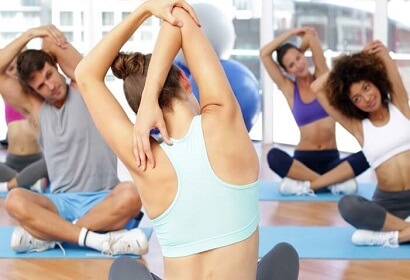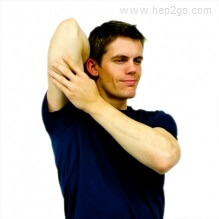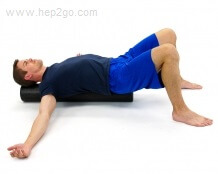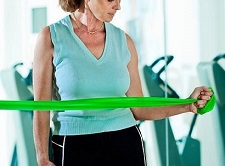- Home
- Shoulder Exercises
- Arm Stretches
Arm Stretches
Written By: Chloe Wilson BSc (Hons) Physiotherapy
Reviewed By: SPE Medical Review Board

Arm stretches can help to improve flexibility and reduce shoulder pain.
Whether you are recovering from an injury, are feeling a bit stiff or are looking for shoulder stretches for when you work out, these arm stretches can help you.
The shoulder is the most mobile joint in the whole body – no other joint moves through such a large range in each direction. But tightness and stiffness can easily develop. Here, we will look at a range of shoulder, arm and rotator cuff stretches to help you improve the movement at your shoulder, increase your flexibility and reduce any shoulder pain.
How To Perform Arm Stretches
Here we will focus on shoulder and upper arm stretches that target the rotator cuff, biceps and triceps muscles. We will start by looking at the purpose of each exercise and then look at how to perform the exercise correctly. You will also find top tips and suggestions on variations or progressions so that you can get the best results from these shoulder stretches.
If you want to find out how to stretch the other muscles around the shoulder, have a look at:
At the end of this page you will find some really useful information on how to stretch safely and effectively with loads of advice on how to get the best results and make sure you don’t injure yourself. Now let’s get started with our arm stretches.
1. Corner Wall Stretch
Purpose: To stretch the front of the shoulder and the pecs (stretches both shoulders at once)
Starting Position: Stand in a corner and place your arms against the wall as shown. Your elbows should be bent, at shoulder height and your forearms resting on the wall.
Action: Step one leg forwards towards the corner and bend the front knee until you feel a stretch across the front of your shoulders and chest. Hold for 15-30 seconds
Repeat: 3-5 times
Top Tips: 1. You can change where you feel the stretch by change the height of your arms – try moving them up or down small amounts to find the best position of stretch for you
2. Control the amount of stretch by bending or straightening your front knee
3. If you are wanting to stretch one shoulder slightly more, as you hold the stretch, twist your body away from that side
2. Sleeper Stretch
Purpose: Improve internal rotation e.g. putting your hand behind your lower back
Starting Position: Lie on your side, your head resting on a pillow, with the arm you want to stretch underneath you. Your elbow should be bent and slightly below the level with your shoulder. Your forearm should be pointing to the ceiling and your palm facing down towards your feet
Action: Using your free hand, gently draw your forearm down towards the bed, feeling a stretch in your shoulder. Hold for 15-30 seconds
Repeat: 3-5 times
3. Wall Twist Stretch
Purpose: Improve external rotation e.g. putting your hand behind your head
Starting Position: Stand at the edge of an open doorway, and place your palm on the inside of the door frame. Your elbow should be bent at a right angle and tucked in to your waist
Action: Keeping your arm still and your elbow tucked in, slowly turn your body away from the door feeling a stretch at the front of your shoulder as you twist round. Hold for 15-30 seconds
Repeat: 3-5 times
4. Triceps Stretch
Purpose: Stretch the triceps muscle on the back of the upper arm
Starting Position: Sitting or standing, raise the arm to be stretched up towards the ceiling aiming to get your elbow covering your ear. Let your elbow bend so that your hand rests on the back of your shoulder
Action: Grasp the elbow with your free hand and gently draw the elbow backwards until you feel a stretch under your arm. Hold for 15-30 seconds
Repeat: 3-5 times
Top Tip: Don’t lean backwards as you do this exercises – keep upright
Progression: You can increase the stretch by 1) Keep pressure through the thumb on your free hand to keep the elbow fully bent
2) Tilt your upper body to the opposite side while maintaining the stretch i.e. if stretching your right arm, tilt to the left
5. Biceps Stretch
Purpose: Stretch the biceps muscles on the front of your upper arm
Starting Position: Stand sideways on to a wall and place the palm of your hand on the wall between shoulder and waist height. Your fingers should be pointing backwards
Action: Step forwards until your elbow is fully straight then gently twist your body away from the wall, feeling a stretch down the front of your upper arm and elbow. Hold for 15-30 seconds
Repeat: 3-5 times
Top Tips: 1. You can increase the stretch by pushing your elbow towards the wall – your arm won’t move but you should feel more of a stretch
2. Changing the height of your hand will slightly change where the stretch is felt – find the best position for you
3. Turn your hand over so that the back of your hand is against the wall to again change where the stretch is felt – do this in addition rather than as a replacement stretch
4. If you notice any pins and needles or numbness in your arm of fingers, stop this exercise immediately
For more ways to stretch the biceps muscles, visit the bicep stretches section.
6. Deltoid Stretch
Purpose: To stretch the back of the Deltoid muscle, behind the shoulder
Starting Position: Sitting or standing, cross the arm to be stretched across the front of your chest
Action: Grasp the elbow with your free hand and draw the arm further across your chest towards your opposite shoulder until you feel a stretch in the back of your shoulder (your elbow can be bent or straight). Hold for 15-30 seconds
Repeat: 3-5 times
Top Tips: 1. Keep your shoulders drawn down – don’t let them creep up by your ears
2. You are aiming to draw the arm around from the elbow, not push the elbow towards the chest
3. Keep your body and hips facing forwards – don’t let them twist round (doing the exercise sitting on a chair makes it easier not to cheat)
7. Prayer Stretch
Purpose: Stretch underneath the shoulder
Starting Position: Kneel on all fours, hands under shoulders, knees under hips
Action: Keeping your hands fixed, gently sit back onto your heels. Hold for 15-30 seconds
Repeat: 3-5 times
Progression: You can increase the stretch by moving your hands further forwards at the start
Top Tip: Have a gap between your knees to allow you to get your chest lower to the ground and increase the stretch
8. Towel Chest Stretch
Purpose: Stretch the front of the shoulder and chest including the pecs.
Starting Position: Roll up a large towel into a cylinder and place it on the floor/bed. Lie down on your back on top of the towel so it is between your shoulder blades and running down the length of your spine in the middle of you back. You may find it more comfortable to bend your knees and have a pillow under your head
Action: Let your shoulders drop back over the towel towards the bed until you feel a stretch in your chest
Repetition: Spend 5-10 minutes like this to fully stretch out – you might want to try some of the variations below during this time
Variations: 1. To feel more of a stretch, draw your shoulder blades backwards towards each other as you lie on the towel
2. Gradually bring your arms out to the side and up above your head to change the position of the stretch. You can try moving the arms slightly, holding for 30 seconds and then move them again – like really slow snow angels
3. Increase the thickness of the rolled up towel underneath you so you are higher off the ground – you can go up to two large bath towels rolled up together
4. You can use a foam or air roller instead of a towel for a more effective stretch
Top Tips: This is one of my favourite arm stretches and is also a great stretch for upper and middle back pain and stiffness. And it’s a great excuse to lie down for 10 minutes!
How to Stretch Safely & Effectively
Arm stretches can make a big difference with a number of different shoulder problems, but it is important to make sure they are done correctly to get the best effect, so there are a few things to be aware of:
Arm Stretches With Injuries
Let me start by reminding you that if you have injured your shoulder, arm stretches may not be the best place to start. You should always check with your doctor or physical therapist before starting any stretches as in some cases they can be counter-productive. There are two reasons for this.
- Stretching can cause further damage particularly with an injury such as a rotator cuff tear as it can over-stress the affected muscles/tendons
- If you are wanting to do arm stretches because there is stiffness in your shoulder, it is important to first find out why there is stiffness. It may be that there is an underlying condition and the stiffness is actually a protective mechanism to prevent further injury.
In both of these cases it may be more appropriate to start with a combination of gentler stretching and strengthening exercises first to improve the mobility, stability and strength of the shoulder muscles before starting to do arm stretches – visit the rotator cuff exercises section to find out more.
What's The Best Way To Stretch?
There is much debate on how best to perform arm stretches with some people preferring large numbers of reps each with a short hold time, and others performing a small bouncing movement at the end of the stretch.
But studies have shown that the most effective way to stretch if you are focused on increasing muscle length, is to hold the stretch for thirty seconds and do three repetitions. This might not be possible at first in which case reduce the hold and increase the number of repetitions of your arm stretches.
How Should Arm Stretches Feel?
In terms of how arm stretches should feel, as long as there is no underlying pathology, stretches should feel a bit uncomfortable – if you can’t feel the stretch, you’re unlikely to change the length of the muscle. But any discomfort should settle quickly, certainly within thirty minutes of stopping the exercise.
If it still feels sore after that, you have likely overdone things – reduce how far you stretch and how long you hold the arm stretch for until there are no ill effects.
When Not To Stretch
Please be aware that if there is an underlying shoulder condition or injury, do not push in to pain with arm stretches as you may do more harm than good. Always follow the guidance of your doctor or physical therapist and don’t be tempted to try and progress too quickly.
What Else Can Help?
Arm stretches will be most effective when combined with strengthening and mobility shoulder exercises as well. Muscles need a combination of strength and length to work properly so it is important to do both.
People often find it helpful to do strengthening exercises alongside their arm stretches, such as:
- Bicep Stretches
- Upper Back Stretches
- Trapezius Stretches
- Rotator Cuff Exercises
- Scapular Stabilization Exercises
- Resistance Band Shoulder Exercises
- Shoulder Impingement Exercises
And remember, if you are getting pain in your shoulder and arm, it's really important to find out what is going, so check out the shoulder pain diagnosis section and talk to your doctor.
Page Last Updated: 09/06/2022
Next Review Due: 09/06/2024











